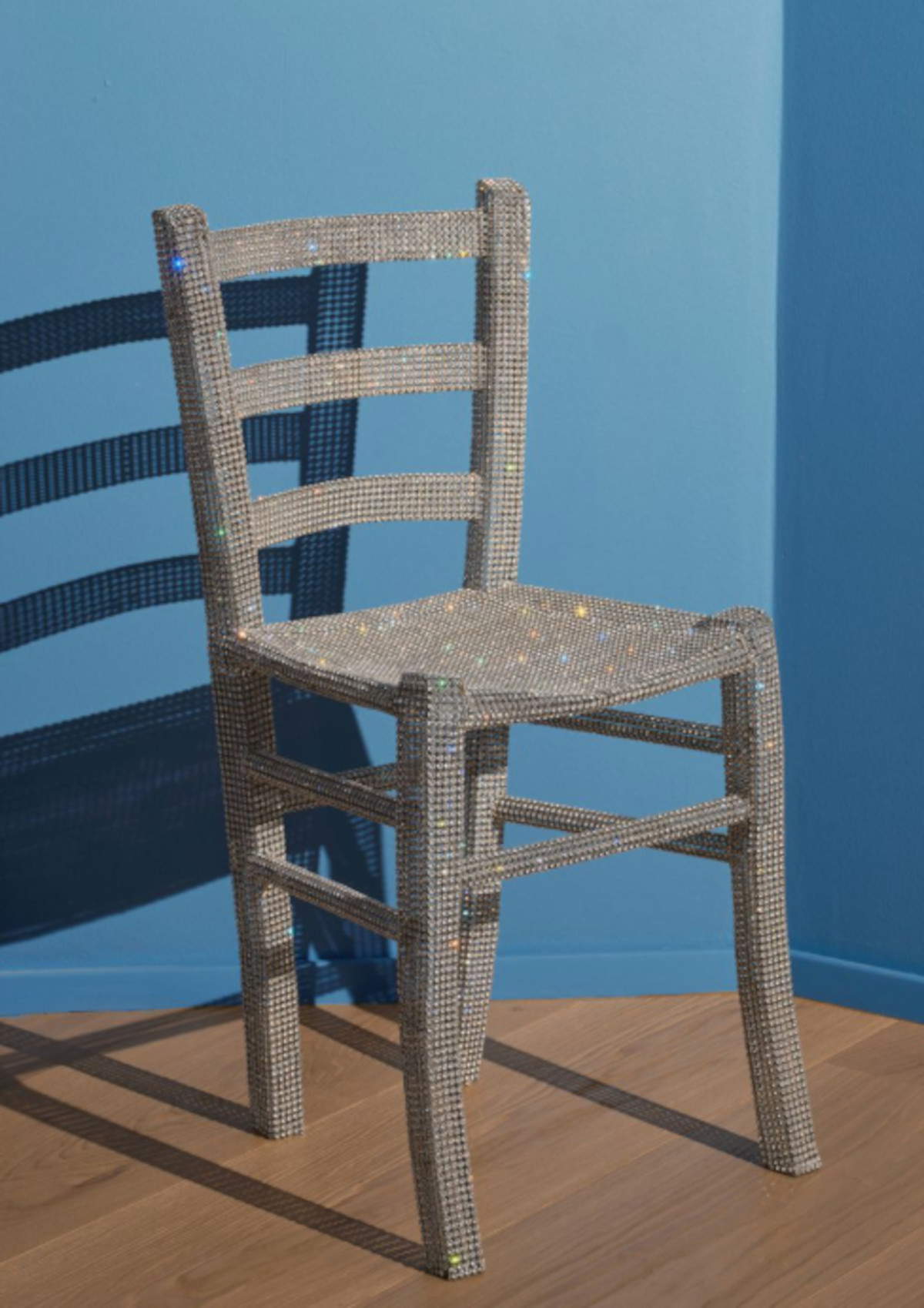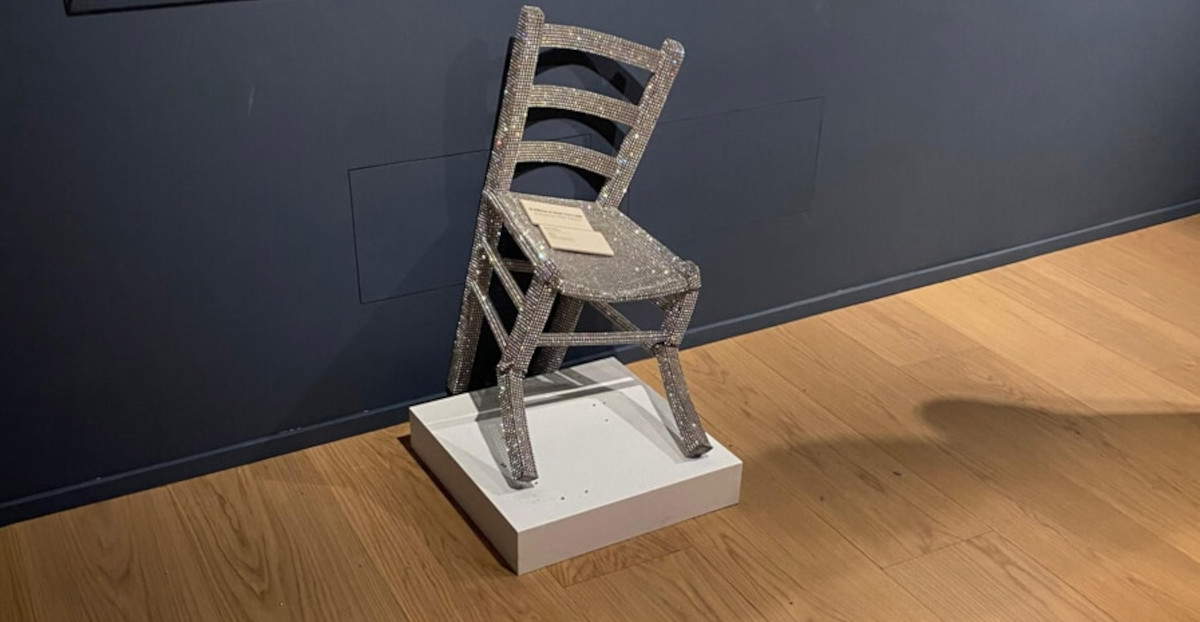Yesterday, June 12, 2025, at theMaffei Palace in Verona, an incident reignited the debate on the value and fragility of contemporary art: two visitors took advantage of the momentary absence of the security staff to photograph themselves sitting on top of the "Van Gogh" chair created by Nicola Bolla, covered in hundreds of Swarovski crystals (you can read about it here). The result is extensive damage to a work that fully embodies the contrast between appearance and substance.
The museum released video of the incident and stressed the importance of protecting the works by announcing the recovery of the artifact. The event, indicative of the complicated relationship the public has with certain contemporary art objects, presents itself as an opportunity to reflect on the significance of the works of Nicola Bolla(here is a lengthy article by Federico Giannini on Bolla’s artistic practice), a Piedmontese artist born in 1963, conceptual sculptor and eye surgeon by profession.

Bolla was born in Saluzzo, in the province of Cuneo, in a family context already steeped in art. His father, Piero Bolla, is a painter; his mother, Silvia Aimone, a set designer. His optical sensibility and interest in drawing thus manifested from an early age. In the 1980s, he followed in his father’s footsteps and began to devote himself to painting, which since 1984 has assumed a constant role in his personal and professional path. At the same time, he continued his studies in medicine, specializing in ophthalmology (a branch of medicine that deals with the prevention and treatment of the visual apparatus): the dual identity, that of doctor and artist, remains a constant in his profile and contributes to consolidating an autonomous practice, free from the logic of the market. In this sense, art for Bolla presents itself as a layered, ironic, pop language, which starts from the figurative tradition to reinterpret it through unexpected materials. Starting in the 1990s, he began to create works that find inspiration in the Wunderkammern, the chambers ofwonders of the Baroque tradition, in which natural, artificial objects, relics, exotic and domestic elements coexisted.

In all this, his approach is never citationist: in his artistic practice the element is reworked, disassembled and later reconfigured according to a contemporary aesthetic that plays on the contrast between form and content. In 1997 he created one of his best-known works: a skull completely covered with Swarovski crystals, entitled Skull. The work anticipates Damien Hirst’s For the Love of God by ten years, which has become emblematic of the relationship between art and the market. But if Hirst insists on economic value and the ostentation of luxury, Bolla employs crystal in a more conceptual, decidedly different reading. The crystal element is not a status symbol. It is seen more as a means of representing the illusion of value, the ambiguity between appearance and substance. Swarovski, in fact, is ground glass, imitating diamond without possessing its properties. It is reflected light, therefore ephemeral, unstable, never fully graspable. Its choice marks a turning point in the artist’s poetics: it has since become a recurring material in installations, sculptures and objects. It is the perfect tool to embody the memento mori, the contemporary vanitas: brilliant, seductive, but at the same time empty, like the promise of luxury that, in truth, is never authentic. Moreover, crystal brings with it an ambiguous physicality: it appears solid but crumbles easily, it imposes itself on the eye but has no weight.

Through the use of Swarovski crystal, Bolla brings forth a reflection on the transience of existence. His works fit into the groove of Baroque vanitas but update its lexicon. They no longer refer to skulls, hourglasses and withered flowers painted in oil, but are instead everyday objects, everyday tools transfigured by a patina of light. The irony is subtle but central. They are elements related to use, to function that lose weight and consistency to become aesthetic, deceptive, unusable figures. In this sense, Bolla decides to destabilize and play with ambivalence. His sculptures appear precious but are weak, seem monumental but are evanescent. Light, a constitutive element of his work, is itself a subject: it crosses surfaces, fragments them, dissolves their contours. Like time and like memory. In the 2000s, Bolla expands his formal register. The installations become more articulated, often site-specific. One of the best known is Orpheus’ Dream, from 2009. Parallel to sculpture, Bolla pursues a less exposed but equally consistent pictorial research. We are talking aboutPigment Paintings, works made with pure pigments, often directly manipulated on the surface, without mediums or canonical supports.

Color becomes living matter and triggers a connection with light that ideally continues that of three-dimensional works. In this sense, we could define Bolla’s painting as a visual and conceptual field in which depth and artifice are confronted. Thus, the work is produced in relation to an internal necessity, an expressive urgency arising from the dual perspective, clinical and poetic. Medicine has taught him to observe, to measure, to operate on the body with precision. Art, on the other hand, allows him to build a parallel discourse, made of allusion and layering. His works want to defuse. They invoke beauty in order to deny it, they attract the gaze in order to undermine it. In this constant tension, here lies the essence Bolla: an artistic practice consistent with his being and autonomous.
 |
| Who is Nicola Bolla, the Swarovski chair artist smashed by selfie-hunting tourists |
Warning: the translation into English of the original Italian article was created using automatic tools. We undertake to review all articles, but we do not guarantee the total absence of inaccuracies in the translation due to the program. You can find the original by clicking on the ITA button. If you find any mistake,please contact us.